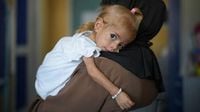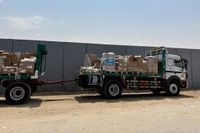On a late summer day in Naples, Italy, a small child’s laughter echoes through the corridors of Santobono Pausilipon Children’s Hospital. Two-year-old Shamm Qudeih, who just weeks ago was fighting for her life in Gaza, now sits upright in her hospital crib, her fine blonde hair pulled into a high ponytail and a T-shirt emblazoned with the word "cute". Her wide eyes light up as her mother and older sister call her name, and a smile breaks across her face—a simple gesture that, for her family and doctors, feels nothing short of miraculous.
Shamm’s journey from Gaza to Italy is a testament to both the resilience of a child and the devastation wrought by conflict and deprivation. According to Associated Press and TVNZ, Shamm was evacuated from Gaza on August 13, 2025, alongside six other Palestinian children, after months of suffering from severe malnutrition exacerbated by a rare genetic metabolic disorder known as glycogen storage disease. When she arrived in Italy, Shamm weighed just 4 kilograms—less than half the median weight for a child her age—and was in a "serious and challenging clinical state," as Dr. Daniele de Brasi, the pediatric genetics specialist treating her, recounted.
Her story, captured in a now-iconic photograph by Associated Press freelancer Mariam Dagga, gripped the world’s attention. The image, taken on August 9, just days before Shamm’s evacuation, shows the toddler wincing in pain in her mother’s arms, her ribs protruding, her hair matted, and her belly swollen from hunger and disease. Tragically, Dagga was killed on August 25, 2025, in an Israeli strike on the same hospital in southern Gaza, one of 22 victims that day. Shamm’s mother, Islam, who had gone to school with Dagga, learned of her friend’s death only after arriving in Italy. "I was upset when I heard and knew that she had died," Islam said, remembering Dagga’s care and presence during their ordeal.
Shamm’s medical crisis began at birth, just weeks before the October 7, 2023, attack by Hamas-led militants that killed around 1,200 people in Israel and resulted in 251 hostages being taken. Israel’s subsequent military response and blockade, aimed at pressuring Hamas to release hostages, brought Gaza to the brink. The Gaza Health Ministry, part of the Hamas-run government, reported more than 64,000 Palestinians killed in nearly two years of fighting, with about half of the victims women and children. The relentless conflict forced Shamm’s family to move more than a dozen times, often living in tents and enduring harsh heat with little access to food or medical care.
"We have been displaced maybe about 15 times, from tent to tent. We walked long distances and, along the way, it was hot, and the sun was hitting us," Islam recounted to Associated Press. Despite visiting numerous hospitals and clinics, doctors in Gaza could only suspect Shamm’s rare genetic condition, lacking the resources to test or treat it properly. Sometimes, they offered antibiotics, but the real solution—a carefully managed, high-carbohydrate diet—was impossible to maintain amid chronic shortages. For a while, Shamm was given a special formula, but she refused it after becoming unaccustomed to milk due to its scarcity in Gaza.
The wider context is equally grim. The world’s leading authority on hunger crises reported in August 2025 that more than half a million people in Gaza—a quarter of the population—are facing catastrophic levels of hunger because of the blockade and ongoing military operations. Gaza City, in particular, has been described as experiencing famine. The United Nations warned that starvation and malnutrition in Gaza are at the highest levels since the war began. In July 2025, nearly 12,000 children under five were found to have acute malnutrition, including more than 2,500 with severe malnutrition—the most dangerous level. The World Health Organization believes these figures are likely underestimates.
Yet, Israeli officials have consistently denied that starvation is occurring in Gaza. Prime Minister Benjamin Netanyahu asserted, "No one is starving in Gaza and enough aid has been supplied during the war, otherwise, there would be no Gazans." Israel claims to have allowed sufficient aid before and after the blockade was tightened and says it has increased supplies in recent weeks. However, UN agencies, witnesses, and independent experts describe a very different reality on the ground, marked by widespread hunger and desperate need.
After her evacuation, Shamm’s treatment in Naples began with immediate nutritional support. Dr. de Brasi explained that "a big part" of her undernourishment was due to her genetic disease, which interferes with the absorption of nutrients, particularly carbohydrates, and can cause muscle weakness and impede growth. The mainstay of her therapy is a high-carbohydrate diet, carefully managed to avoid complications from refeeding too quickly. At first, Shamm received around 500 calories a day—an amount now being gradually increased. Overnight, nutrients are delivered via a feeding tube in her nose, while during the day she is encouraged to eat solid foods like porridge, meat, and fish. Doctors hope to remove the feeding tube in about a month if her progress continues.
Shamm is not alone in her recovery. Her 10-year-old sister, Judi, accompanied her to Italy as a family member and was also found to be underweight. Since arriving, Judi has gained two kilograms and is now in good condition, according to Dr. de Brasi. The Italian Foreign Ministry reports that Shamm is one of 181 Palestinian children currently being treated in Italy, with about a third of those arrivals occurring since March 2025, when Israel ended a ceasefire with Hamas and imposed a strict blockade on all imports, including food and medicine.
For Shamm’s mother, Islam, the relief of seeing her daughters recover is tempered by the ongoing reality in Gaza. "Now there is no way to go back, as long as the war is going on. There are no possibilities for my daughters," she told Associated Press. Her husband, Shamm’s father, remains in Gaza, separated from his family by conflict and uncertainty. As Shamm gains strength and Judi thrives, Islam allows herself a moment of hope, but the future remains deeply uncertain.
Shamm’s story is one of survival against daunting odds, but it also casts a harsh light on the humanitarian crisis still unfolding in Gaza. Her recovery is a small victory—a testament to the power of medical intervention, international cooperation, and a mother’s determination. But for thousands of children still trapped by war and deprivation, the struggle for life and health continues, far from the safety and care found in a Naples hospital room.





